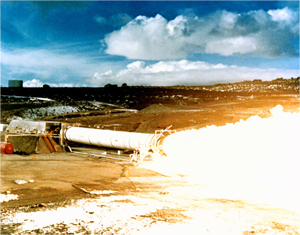History of NASA’s Solid Rocket Boosters (SRBs)
The Solid Rocket Boosters (SRBs) operated in parallel with the Space Shuttle Main Engines for the first two minutes of flight to provide the additional thrust needed for the Orbiter to escape the gravitational pull of the Earth. At an altitude of approximately 45 km (24 nautical miles), the boosters separated from the orbiter/external tank, descended with parachutes, and landed in the Atlantic Ocean. They were recovered by ships, returned to land, and refurbished for reuse. The boosters also assisted in guiding the entire vehicle during initial ascent. Thrust of both boosters is equal to 5,300,000 lbs.
The solid rocket motor is the largest solid propellant motor ever developed for space flight and the first built to be used on a manned craft. The huge motor is composed of a segmented motor case loaded with solid propellants, an ignition system, a movable nozzle and the necessary instrumentation and integration hardware.
For more information on the Solid Rocket Boosters, click here.



























